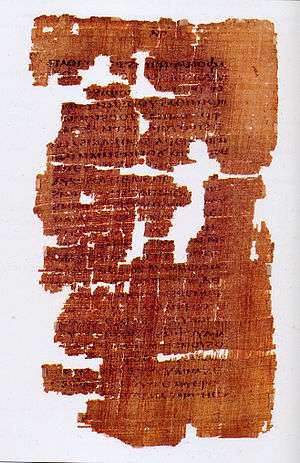Acts of Peter and Paul
The Acts of Peter and Paul is a pseudepigraphical 4th century Christian text of the genre Acts of the Apostles. An alternate version exists, known as the Passion of Peter and Paul (Passio sanctorum Petri et Pauli), with variances in the introductory part of the text. Some versions have been written by a certain Marcellus, thus the anonymous author, of whom nothing further is known and is sometimes referred to as pseudo-Marcellus. The intended Marcellus is doubtless he who after the martyrdom takes the lead in burying St. Peter "near the Naumachia in the place called the Vatican."[1]
| Part of a series of articles on |
| Paul in the Bible |
|---|
.jpg) |
|
See also
|
Synopsis
The text is framed as the tale of Paul's journey from the island of Gaudomeleta to Rome, where it also claims that on the way the ship also lands in Melita.[2] It assigns Peter as Paul's brother. It also describes the death of Paul by beheading, an early church tradition.
Acts of Pilate
The text often includes a letter purporting to be from Pilate, known as Acts of Pilate (or Epistle of Pontius Pilate).
Origins
The Passio, which appears in numerous medieval manuscripts,[3] was known to Jacobus de Voragine who noted in his vita[4] of the Apostle Peter, "His martyrdom wrote Marcellus, Linus pope, Hegesippus, and Leo the pope." There are two Old English analogues, Ælfric's Passio Apostolorum Petri et Pauli and the anonymous Blickling Homily 15, Spel Be Petrus & Paulus.[5]
The work appears to have been based on the Acts of Peter, with the addition of Paul's presence where before it was only Peter's. The work is dated to around 450 to 550. Latin as well as Greek versions survive, with the latter usually being longer. The Latin versions sometimes end with "I, Marcellus, have written what I saw." This Marcellus is identified as a disciple of Simon Magus, who lived in the 1st century. Because of this obvious anachronism, since the text is clearly written centuries later, scholars have dubbed him Pseudo-Marcellus.[6]
References
- Edmundson ref.
- Busuttil, Joseph (1971). "Maltese Harbours in Antiquity". Melita Historica: Malta Historical Society. 5 (4): 305–307.
- R.A. Lipsius, ed., Acta apostolorum apocrypha vol. I (Leipzig) 1891, Prolegomena, pp lxxvff; E. Hennecke and W. Schneemelcher, New Testament Apocrypha, vol. II (Philadelphia) 1964.
- Legenda Aurea.
- Joyce Tally Lionarons
- Schmisek, Brian (2017). The Rome of Peter and Paul: A Pilgrim's Handbook to New Testament Sites in the Eternal City. Wipf and Stock Publishers. p. 18. ISBN 9781532613098. Retrieved 19 July 2018.
- Translation of the Acts of Peter and Paul at the New Advent website
Bibliography
- Schøyen Collection: MS 1679: Vellum ms from Bobbio, tenth century.
- Text, edited by R.A. Lipsius and M. Bonnet (in Latin)
- George Edmundson, The Church in Rome in the First Century, note E
Further reading
- Tajra, H.W. (1994). The Martyrdom of St. Paul: Historical and Judicial Context, Traditions, and Legends. 2]. J.C.B. Mohr. p. 144ff. ISBN 978-3-16-146239-9. Retrieved 29 June 2018.CS1 maint: extra punctuation (link)
